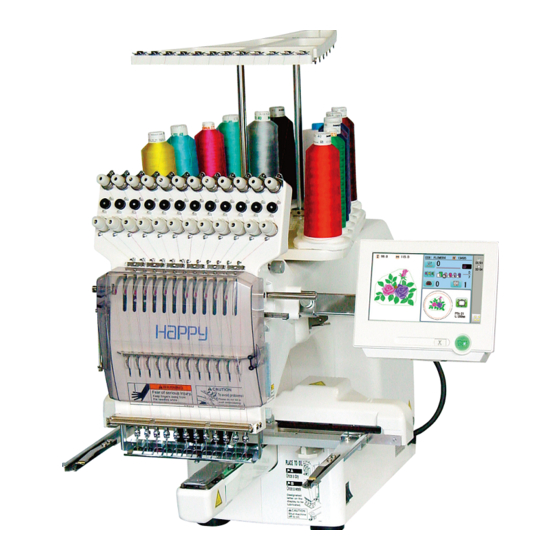
Advertisement
Quick Links
Education Department
Training:
HAPPY HCS2-1201 Operations & Maintenance
For HCS Voyager2 with Touch Screen
Chapter 1: Introduction: The Machine, Needle, and Thread
–
Introduction to your machine p.2
•
Diagram of major parts p. 2
•
Diagram of major systems: Pantograph, sewing machine, color change/cut p.3
•
The Sewing Cycle p. 4
•
Machine environment p.5
–
Control Panel Introduction & Orientation p.6
•
Power on/off / emergency stop
•
Power-on & navigating to the main sewing screen
–
Important Screens: A brief introduction p.7
•
Drive screen 7
•
Important Sub Screens 8
•
Main menu, 9
–
Additional Basics p.10
•
About stitches, sewing quality, stitch file formats
–
Embroidery Thread p. 11
•
Installing thread p. 12
•
Bobbin thread p. 14
–
Embroidery Needles p. 15
Chapter 1: Introduction and Basics
Training Workbook: HAPPY HCS2-1201 Voyager Operation and Maintenance
1
Advertisement

Summary of Contents for Happy HCS2-1201
- Page 1 Training Workbook: HAPPY HCS2-1201 Voyager Operation and Maintenance Education Department Training: HAPPY HCS2-1201 Operations & Maintenance For HCS Voyager2 with Touch Screen Chapter 1: Introduction: The Machine, Needle, and Thread – Introduction to your machine p.2 • Diagram of major parts p. 2 •...
- Page 2 Training Workbook: HAPPY HCS2-1201 Voyager Operation and Maintenance Education Department Introduction: A Quick Tour of the Machine tree Manual needle selector knob Safety Cover upper-tensioning knobs Take-up Thread posts thread break sensors lever lower tensioning knobs base Emergency Stop Switch...
- Page 3 Training Workbook: HAPPY HCS2-1201 Voyager Operation and Maintenance Education Department Introduction: 3 key mechanical systems 2. Sewing System 1. Color Change System Take-Up Lever Moving head Needle bar Thread cut system Rotary hook / bobbin take-up lever Moving head Currently selected needle is the one directly over the presser foot.
- Page 4 Training Workbook: HAPPY HCS2-1201 Voyager Operation and Maintenance Education Department Basics: Lock Stitch Formation (sewing cycle) Lock Stitch Illustrated. How Each Part of the Notice how the top thread only half-loops with the bobbin Cycle Works thread for every stitch The key parts of the sewing cycle.
- Page 5 Training Workbook: HAPPY HCS2-1201 Voyager Operation and Maintenance Education Department Proper Machine Environment Temperature and Humidity-Controlled Environment Set up/store your machine in a temperature and humidity-controlled environment to prevent long-term corrosion and to protect the electronics. Don’t keep your machine anywhere you wouldn’t keep a laptop or desktop computer !
- Page 6 Training Workbook: HAPPY HCS2-1201 Voyager Operation and Maintenance Education Department Control Panel Intro: Power On to the Main (Drive) Screen Power On Power on your machine with the black switch located on the side of the machine. The screen below appears.
- Page 7 Training Workbook: HAPPY HCS2-1201 Voyager Operation and Maintenance Education Department Control Panel Intro: Power On to the Main (Drive) Screen The Sewing/Drive Screen This is the main “drive” screen. The machine needs to be in this mode to sew or to accept design transfers by PC connection.
- Page 8 Training Workbook: HAPPY HCS2-1201 Voyager Operation and Maintenance Education Department Control Panel Intro: Other Important Screens Shown below are the important subscreens directly accessible from the Drive screen by a single button: Sewing Position Screen Jump to any position in the design using this screen, by piece #, by color block# or by stitch#.
-
Page 9: The Main Menu
Training Workbook: HAPPY HCS2-1201 Voyager Operation and Maintenance Education Department Control Panel Intro: Other Important Screens The Main Menu The other - and most important - menu is the Main Menu, accessed from the main Drive screen by pressing MENU as shown below. - Page 10 Does not have color information – must load the design into the machine AND tell it which colors to sew. – Limited in editability. Not resized or adjusted easily for different types of garments without compromising quality. – Happy machines will also read HAPPY (.TAP) and Melco (.EXP) format. Chapter 1: Introduction and Basics...
-
Page 11: Embroidery Thread
Training Workbook: HAPPY HCS2-1201 Voyager Operation and Maintenance Education Department Embroidery Thread • Upper (colored) thread Typical 5000 meter “king” – Can be polyester or rayon, usually polyester. Standard is 40 weight cone of thread – Comes in several sizes: 5,000 meter cones to 1,000 meter cones. - Page 12 Training Workbook: HAPPY HCS2-1201 Voyager Operation and Maintenance Education Department Embroidery Thread Replacement cones can be tied in here and pulled Installation of upper thread on your machine through so the thread doesn’t have to be run manually through the thread path. (See next page)
- Page 13 Training Workbook: HAPPY HCS2-1201 Voyager Operation and Maintenance Education Department Embroidery Thread Thread Path through the moving head Upper Tensioner -Proper Thread Routing: All threads must be routed Thread only makes ½ turn – make sure correctly at all points along the path through the sewing it passes to the left head.
- Page 14 Training Workbook: HAPPY HCS2-1201 Voyager Operation and Maintenance Education Department Embroidery Thread Bobbin Loading and Tension Check/Adjustment RE-LOADING THE BOBBIN CORRECTLY The bobbin will need to be replaced frequently, allowing only 30,000 to 60,000 stitches per spool. This has to be done correctly every time.
- Page 15 Training Workbook: HAPPY HCS2-1201 Voyager Operation and Maintenance Education Department Embroidery Needles – Type DB-K5, standard size is 75/11 ballpoint for most applications. Alternate needle for sewing caps and other tightly-woven goods (heavy canvas) is 80/12 sharp point for better penetration –...








Need help?
Do you have a question about the HCS2-1201 and is the answer not in the manual?
Questions and answers